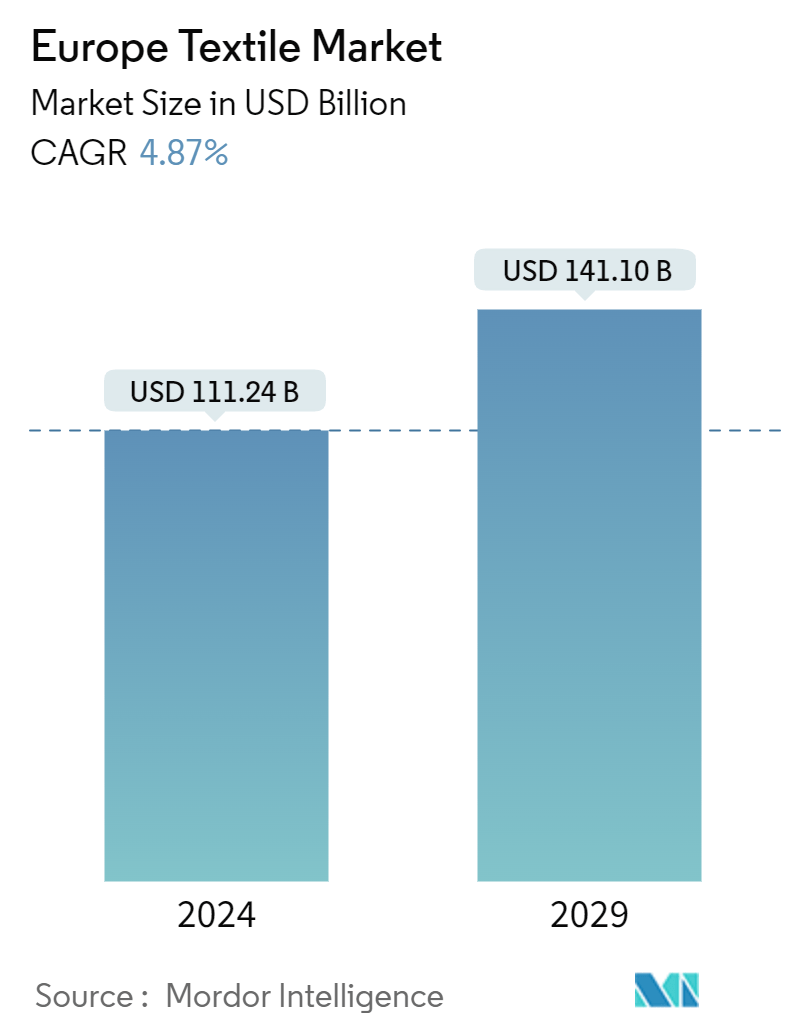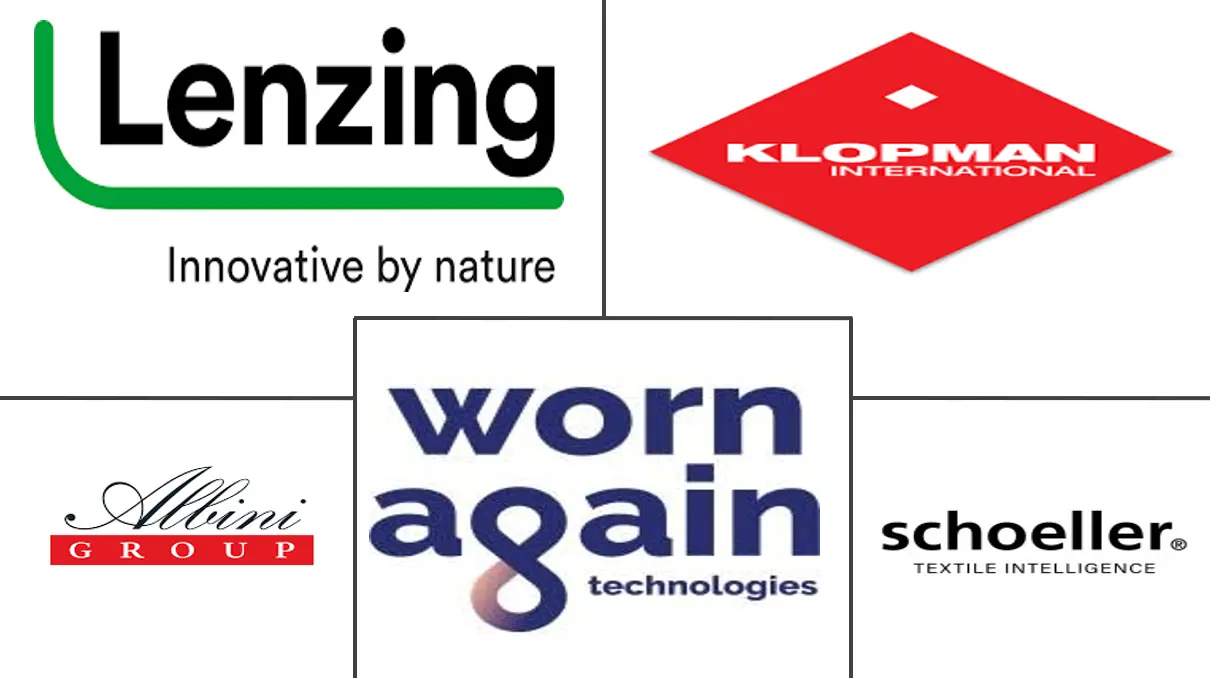Market Size of Europe Textile Industry

| Study Period | 2020 - 2029 |
| Base Year For Estimation | 2023 |
| Market Size (2024) | USD 111.24 Billion |
| Market Size (2029) | USD 141.10 Billion |
| CAGR (2024 - 2029) | 4.87 % |
| Market Concentration | Medium |
Major Players
*Disclaimer: Major Players sorted in no particular order |
Europe Textile Market Analysis
The Europe Textile Market size is estimated at USD 111.24 billion in 2024, and is expected to reach USD 141.10 billion by 2029, growing at a CAGR of 4.87% during the forecast period (2024-2029).
In Europe, the textile industry is a cornerstone of the manufacturing workforce. Consumer behavior has shifted noticeably toward embracing the latest fashion trends, particularly among the younger generation. The introduction of new collections every three weeks has fueled this trend, encouraging consumers to adopt more frequent purchasing habits.
Digital platforms and online marketing strategies have gained prominence in the European fashion market, leading to the emergence of numerous new brands leveraging e-commerce platforms. These digital channels, along with innovations such as virtual reality, have enabled companies to engage with consumers in novel ways. The fashion and apparel sector has experienced significant growth in e-commerce sales, contributing to overall revenue growth in the European textile market.
The rise of online platforms has facilitated increased consumer spending on clothing through digital channels, further fueling sales growth in the textile market in Europe.
Europe Textile Industry Segmentation
The textile market encompasses the entire process from development and production to processing, manufacturing, and distribution of textile and fabric materials. It involves designing and producing yarn, clothing, and garments. Raw materials, including those derived from chemical sources, can be natural and synthetic.
The European textile market is segmented into application type, material type, process type, and region. By application type, the market is segmented into clothing, industrial/technical applications, and household applications. By material type, the market is segmented into cotton, jute, silk, synthetics, and wool. By process type, the market is segmented into woven and non-woven. By region, the market is segmented into Germany, France, Italy, Spain, the United Kingdom, and the rest of Europe. The report offers market size and forecasts in terms of value (USD) for all the above segments.
| By Application Type | |
| Clothing | |
| Industrial/Technical Applications | |
| Household Applications |
| By Material Type | |
| Cotton | |
| Jute | |
| Silk | |
| Synthetics | |
| Wool |
| By Process Type | |
| Woven | |
| Non-woven |
| By Region | |
| Germany | |
| France | |
| Italy | |
| Spain | |
| United Kingdom | |
| Rest of Europe |
Europe Textile Market Size Summary
The European textile industry plays a crucial role in the continent's economy, employing a significant portion of the manufacturing workforce. The sector is experiencing a transformation driven by digitalization and changing consumer behaviors, particularly among younger demographics who are increasingly drawn to the latest fashion trends. The rise of e-commerce and digital marketing has facilitated the emergence of new brands and enhanced consumer engagement through innovative platforms. This shift has led to a notable increase in online apparel sales, contributing to the overall growth of the European textile market. Additionally, there is a growing demand for organic and sustainable textiles, as consumers become more environmentally conscious. The industry is responding by investing in research and development to create eco-friendly products, with major brands incorporating organic and recycled materials into their offerings.
The market is further bolstered by rising disposable incomes and a preference for online shopping, which varies across different regions. European consumers allocate a significant portion of their expenditure to clothing, with a notable demand for premium and branded products. The region is home to numerous leading retailers, designers, and innovative entrepreneurs, contributing to the high demand for European textiles and fashion products both domestically and internationally. Technical textiles have also seen success, with continuous growth in trade. Key players in the industry, such as Salvatore Ferragamo SpA, Koninklijke Ten Cate NV, and Inditex, are instrumental in driving market expansion. Recent acquisitions, like Lectra's purchase of TextileGenesis‚Ñ¢ and Archroma's acquisition of Huntsman's Textile Effects business, highlight the industry's focus on sustainability and innovation.
Europe Textile Market Size - Table of Contents
-
1. MARKET INSIGHTS AND DYNAMICS
-
1.1 Market Overview
-
1.2 Value Chain/Supply Chain Analysis
-
1.3 Market Drivers
-
1.3.1 Rapid Changes in Fashion Trends and the Rise of Fast Fashion Contribute to Increased Textile Consumption and Demand for New Designs
-
1.3.2 Increased Urbanization and Changing Lifestyles Boost Demand for a Variety of Textile Products, From Home Furnishings to Clothing
-
-
1.4 Market Restraints
-
1.4.1 Elevated Costs of Raw Materials and Manufacturing Processes Can Limit Profitability and Price Competitiveness
-
-
1.5 Market Opportunities
-
1.5.1 Strategic Collaborations with Designers and Other Industry Players
-
1.5.2 Expanding into Emerging European Markets with Growing Middle-income Populations Can Drive Additional Demand for Textile Products
-
-
1.6 Porter's Five Forces Analysis
-
1.6.1 Bargaining Power of Suppliers
-
1.6.2 Bargaining Power of Buyers/Consumers
-
1.6.3 Threat of New Entrants
-
1.6.4 Threat of Substitute Products
-
1.6.5 Intensity of Competitive Rivalry
-
-
1.7 Impact of COVID-19 on the Market
-
1.8 Insights into Latest Technologies Used in the Industry
-
-
2. MARKET SEGMENTATION
-
2.1 By Application Type
-
2.1.1 Clothing
-
2.1.2 Industrial/Technical Applications
-
2.1.3 Household Applications
-
-
2.2 By Material Type
-
2.2.1 Cotton
-
2.2.2 Jute
-
2.2.3 Silk
-
2.2.4 Synthetics
-
2.2.5 Wool
-
-
2.3 By Process Type
-
2.3.1 Woven
-
2.3.2 Non-woven
-
-
2.4 By Region
-
2.4.1 Germany
-
2.4.2 France
-
2.4.3 Italy
-
2.4.4 Spain
-
2.4.5 United Kingdom
-
2.4.6 Rest of Europe
-
-
Europe Textile Market Size FAQs
How big is the Europe Textile Market?
The Europe Textile Market size is expected to reach USD 111.24 billion in 2024 and grow at a CAGR of 4.87% to reach USD 141.10 billion by 2029.
What is the current Europe Textile Market size?
In 2024, the Europe Textile Market size is expected to reach USD 111.24 billion.

